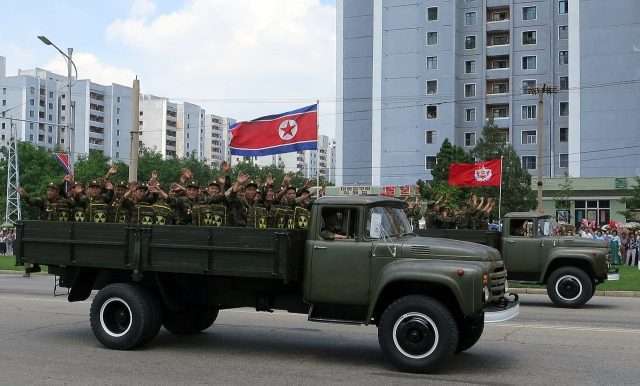
Author: Riccardo Rossi
North Korea stretched its muscle by launching a short-range submarine ballistic missile, which confirmed that Pyongyang is a decisive military actor in Asia-Pacific that might threaten South Korea and contrast the U.S. presence in the region.
On May 7th, 2022, as reported in the press release of the Joint Chiefs of Staff (JCS) of the Republic of Korea, the Democratic People’s Republic of Korea (DPRK) launched from its submarine (probably Sinpo-class, located in the waters of the Sea of Japan near the North Korean Sinpo Navy base) a KN-23 short-range submarine-launched ballistic missile (SLBM) that travelled a distance of approximately 600 kilometres.
Geopolitical Scenario
The DPRK’s decision to conduct a launch from a Sinpo-class conventional ballistic missile submarine (SSB) of a KN-23 SLBM follows the measure taken three days earlier by Kim Jong-Un to complete an intercontinental ballistic missile (ICBM) test launch at the North Korean Army base in Susan, (near the capital Pyongyang).
In the DPRK’s geopolitical vision, these two missile exercises are part of an articulated political-military line drawn up by the Kim-Jong Un presidency for the Korean peninsula, aimed at pursuing a dual geopolitical objective:
-
Kim-Jong Un intends to show the state parties of the Northwest Asia-Pacific region, especially the new South Korean presidency of conservative Yoon Suk-yeol, the strategic missile capabilities possessed by the DPRK. These capabilities are summarised in the Sinpo-class conventional ballistic missile submarines (SSBs), equipped with KN-23 short-range missiles and the arsenal of the Korean People’s Army Strategic Rocket Force (KPASRF), including medium-range missile platforms (Hwasong-13, Pukkŭksŏng-1/2) and long-range missiles such as intercontinental ballistic missiles (ICBM), such as the Hwasong-17 tested on 24/03/2022 by the KPASRF. (The new North Korean missile platforms and the strategic consequences in the Asia-Pacific).
-
North Korean presidency wants to assert the need to protect the territorial integrity of the DPRK from the U.S. threat, identified in the U.S. Navy, Army and Airforce bases located in the Japanese archipelago and South Korea. In Pyongyang’s geostrategic vision, in the event of a possible conflict with Seoul, Washington would most likely employ its military outposts in Japan and South Korea as a launching point for power projection operations against the military installations of the North Korean army and missions aimed at imposing their sea control near the Korean straits and in the Yellow Sea. (Russian-Japanese relations and the Sea of Japan).
In addition to this fear, the Kim-Jong Un presidency, in assonance with the People’s Republic of China (PRC), judges the decision made in 2017 by the South Korean government of Moon Jae-in in agreement with the Obama presidency to install the Terminal High Altitude Area Defense (THAAD) missile defence system, a tangible threat to the survival of the DPRK.
Risk Assessment
Missile tests conducted by the Democratic People’s Republic of Korea from April 23rd, 2022, to May 7th, 2022, have increased geopolitical instability on the Korean Peninsula.
This increase in political-strategic uncertainty in Korea has raised the concerns of the U.S. Presidency of Joe Biden and the Sino-Russian partnership, which identify North Korea as a strategically vital space for their respective national interests since it is contiguous to the corresponding territories (U.S. maritime military presence near the Korean peninsula). Faced with this consideration, the Xi Jinping administration has been economically supporting Pyongyang for years so that Kim Jong-Un’s regime continues to function as a buffer state separating the Russian-Chinese territories from the Republic of Korea and the U.S. military bases located near Seoul and Japan (Geostrategy and military competition in the Korean Peninsula).
Over the last few years, the implementation by the United Nations of a series of economic sanctions against North Korea as a response to the missile tests conducted by Kim-Jong Un’s regime has led the People’s Republic of China to progressively reduce both the acquisition from Pyongyang of raw materials (primarily copper and coal) and the sale of crude oil to the North Korean regime.
At the same time, the Xi Jinping Presidency has deepened its economic-diplomatic relations with the Republic of Korea, leading to an increase in foreign direct investment (FID) from Chinese SOEs into Seoul’s domestic economy, which reached approximately $7.05 billion in 2020.
The Chinese political-economic penetration in South Korea has partly required the People’s Republic of China to increase its influence and pressure on Kim-Jong Un’s regime to preserve a situation of geopolitical stability in the Korean peninsula, a necessary condition to avoid the formation of a geopolitical crisis in the island area that could damage Chinese interests and compromise the investments made by the big industrial companies of the PRC in South Korea and Japan.



